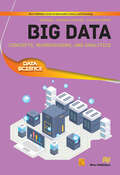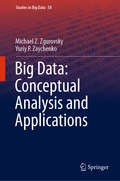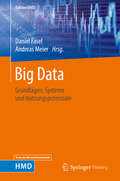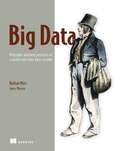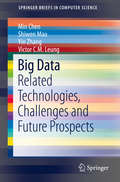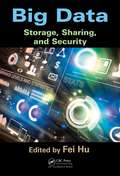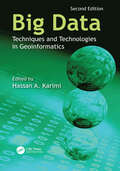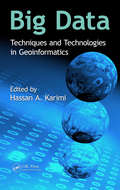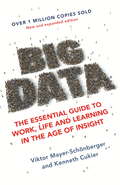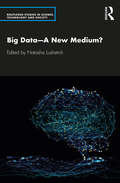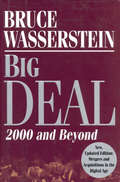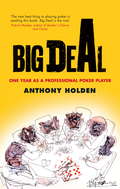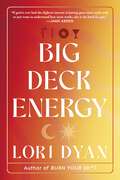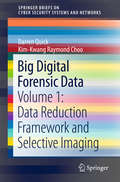- Table View
- List View
Big Data: Concepts, Warehousing, and Analytics
by Carlos Costa Maribel Yasmina SantosBig Data is a concept of major relevance in today’s world, sometimes highlighted as a key asset for productivity growth, innovation, and customer relationship, whose popularity has increased considerably during the last years. Areas like smart cities, manufacturing, retail, finance, software development, environment, digital media, among others, can benefit from the collection, storage, processing, and analysis of Big Data, leveraging unprecedented data-driven workflows and considerably improved decision-making processes.The concept of a Big Data Warehouse (BDW) is emerging as either an augmentation or a replacement of the traditional Data Warehouse (DW), a concept that has a long history as one of the most valuable enterprise data assets. Nevertheless, research in Big Data Warehousing is still in its infancy, lacking an integrated and validated approach for designing and implementing both the logical layer (data models, data flows, and interoperability between components) and the physical layer (technological infrastructure) of these complex systems. This book addresses models and methods for designing and implementing Big Data Systems to support mixed and complex decision processes, giving special attention to BDWs as a way of efficiently storing and processing batch or streaming data for structured or semi-structured analytical problems.
Big Data: Conceptual Analysis and Applications (Studies in Big Data #58)
by Yuriy P. Zaychenko Michael Z. ZgurovskyThe book is devoted to the analysis of big data in order to extract from these data hidden patterns necessary for making decisions about the rational behavior of complex systems with the different nature that generate this data. To solve these problems, a group of new methods and tools is used, based on the self-organization of computational processes, the use of crisp and fuzzy cluster analysis methods, hybrid neural-fuzzy networks, and others. The book solves various practical problems. In particular, for the tasks of 3D image recognition and automatic speech recognition large-scale neural networks with applications for Deep Learning systems were used. Application of hybrid neuro-fuzzy networks for analyzing stock markets was presented. The analysis of big historical, economic and physical data revealed the hidden Fibonacci pattern about the course of systemic world conflicts and their connection with the Kondratieff big economic cycles and the Schwabe–Wolf solar activity cycles. The book is useful for system analysts and practitioners working with complex systems in various spheres of human activity.
Big Data: Grundlagen, Systeme und Nutzungspotenziale (Edition HMD)
by Andreas Meier Daniel FaselDieser Herausgeber-Band bietet eine umfassende Einführung in das Gebiet Big Data. Neben einer Markteinschätzung und grundlegenden Konzepten (semantische Modellbildung, Anfragesprachen, Konsistenzgewährung etc. ) werden wichtige NoSQL-Systeme (Key/Value Store, Column Store, Document Store, Graph Database) vorgestellt und erfolgreiche Anwendungen aus unterschiedlichen Perspektiven erläutert. Eine Diskussion rechtlicher Aspekte und ein Vorschlag zum Berufsbild des Data Scientist runden das Buch ab. Damit erhält die Leserschaft Handlungsempfehlungen für die Nutzung von Big-Data-Technologien im Unternehmen.
Big Data: Principles and best practices of scalable realtime data systems
by James Warren Nathan MarzSummaryBig Data teaches you to build big data systems using an architecture that takes advantage of clustered hardware along with new tools designed specifically to capture and analyze web-scale data. It describes a scalable, easy-to-understand approach to big data systems that can be built and run by a small team. Following a realistic example, this book guides readers through the theory of big data systems, how to implement them in practice, and how to deploy and operate them once they're built.Purchase of the print book includes a free eBook in PDF, Kindle, and ePub formats from Manning Publications.About the BookWeb-scale applications like social networks, real-time analytics, or e-commerce sites deal with a lot of data, whose volume and velocity exceed the limits of traditional database systems. These applications require architectures built around clusters of machines to store and process data of any size, or speed. Fortunately, scale and simplicity are not mutually exclusive.Big Data teaches you to build big data systems using an architecture designed specifically to capture and analyze web-scale data. This book presents the Lambda Architecture, a scalable, easy-to-understand approach that can be built and run by a small team. You'll explore the theory of big data systems and how to implement them in practice. In addition to discovering a general framework for processing big data, you'll learn specific technologies like Hadoop, Storm, and NoSQL databases.This book requires no previous exposure to large-scale data analysis or NoSQL tools. Familiarity with traditional databases is helpful.What's InsideIntroduction to big data systemsReal-time processing of web-scale dataTools like Hadoop, Cassandra, and StormExtensions to traditional database skillsAbout the AuthorsNathan Marz is the creator of Apache Storm and the originator of the Lambda Architecture for big data systems. James Warren is an analytics architect with a background in machine learning and scientific computing.Table of ContentsA new paradigm for Big DataPART 1 BATCH LAYERData model for Big DataData model for Big Data: IllustrationData storage on the batch layerData storage on the batch layer: IllustrationBatch layerBatch layer: IllustrationAn example batch layer: Architecture and algorithmsAn example batch layer: ImplementationPART 2 SERVING LAYERServing layerServing layer: IllustrationPART 3 SPEED LAYERRealtime viewsRealtime views: IllustrationQueuing and stream processingQueuing and stream processing: IllustrationMicro-batch stream processingMicro-batch stream processing: IllustrationLambda Architecture in depth
Big Data: Related Technologies, Challenges and Future Prospects (SpringerBriefs in Computer Science)
by Min Chen Shiwen Mao Yin Zhang Victor C. M. LeungThis Springer Brief provides a comprehensive overview of the background and recent developments of big data. The value chain of big data is divided into four phases: data generation, data acquisition, data storage and data analysis. For each phase, the book introduces the general background, discusses technical challenges and reviews the latest advances. Technologies under discussion include cloud computing, Internet of Things, data centers, Hadoop and more. The authors also explore several representative applications of big data such as enterprise management, online social networks, healthcare and medical applications, collective intelligence and smart grids. This book concludes with a thoughtful discussion of possible research directions and development trends in the field. Big Data: Related Technologies, Challenges and Future Prospects is a concise yet thorough examination of this exciting area. It is designed for researchers and professionals interested in big data or related research. Advanced-level students in computer science and electrical engineering will also find this book useful.
Big Data: Storage, Sharing, and Security
by Fei HuAlthough there are already some books published on Big Data, most of them only cover basic concepts and society impacts and ignore the internal implementation details-making them unsuitable to R&D people. To fill such a need, Big Data: Storage, Sharing, and Security examines Big Data management from an R&D perspective. It covers the 3S desi
Big Data: Techniques and Technologies in Geoinformatics
by Hassan A. KarimiOver the past decade, since the publication of the first edition, there have been new advances in solving complex geoinformatics problems. Advancements in computing power, computing platforms, mathematical models, statistical models, geospatial algorithms, and the availability of data in various domains, among other things, have aided in the automation of complex real-world tasks and decision-making that inherently rely on geospatial data. Of the many fields benefiting from these latest advancements, machine learning, particularly deep learning, virtual reality, and game engine, have increasingly gained the interest of many researchers and practitioners. This revised new edition provides up-to-date knowledge on the latest developments related to these three fields for solving geoinformatics problems.FEATURES Contains a comprehensive collection of advanced big data approaches, techniques, and technologies for geoinformatics problems Provides seven new chapters on deep learning models, algorithms, and structures, including a new chapter on how spatial metaverse is used to build immersive realistic virtual experiences Presents information on how deep learning is used for solving real-world geoinformatics problems This book is intended for researchers, academics, professionals, and students in such fields as computing and information, civil and environmental engineering, environmental sciences, geosciences, geology, geography, and urban studies.
Big Data: Techniques and Technologies in Geoinformatics
by Hassan A. KarimiBig data has always been a major challenge in geoinformatics as geospatial data come in various types and formats, new geospatial data are acquired very fast, and geospatial databases are inherently very large. And while there have been advances in hardware and software for handling big data, they often fall short of handling geospatial big data ef
Big Data: The Essential Guide to Work, Life and Learning in the Age of Insight
by Viktor Mayer-Schonberger Kenneth CukierNew and expanded edition.An International Bestseller - Over One Million Copies Sold!Shortlisted for the Financial Times/Goldman Sachs Business Book of the Year Award.Since Aristotle, we have fought to understand the causes behind everything. But this ideology is fading. In the age of big data, we can crunch an incomprehensible amount of information, providing us with invaluable insights about the what rather than the why.We're just starting to reap the benefits: tracking vital signs to foresee deadly infections, predicting building fires, anticipating the best moment to buy a plane ticket, seeing inflation in real time and monitoring social media in order to identify trends. But there is a dark side to big data. Will it be machines, rather than people, that make the decisions? How do you regulate an algorithm? What will happen to privacy? Will individuals be punished for acts they have yet to commit? In this groundbreaking and fascinating book, two of the world's most-respected data experts reveal the reality of a big data world and outline clear and actionable steps that will equip the reader with the tools needed for this next phase of human evolution.
Big Data—A New Medium? (Routledge Studies in Science, Technology and Society)
by Natasha LushetichDrawing on a range of methods from across science and technology studies, digital humanities and digital arts, this book presents a comprehensive view of the big data phenomenon. Big data architectures are increasingly transforming political questions into technical management by determining classificatory systems in the social, educational, and healthcare realms. Data, and their multiple arborisations, have become new epistemic landscapes. They have also become new existential terrains. The fundamental question is: can big data be seen as a new medium in the way photography or film were when they first appeared? No new medium is ever truly new. It’s always remediation of older media. What is new is the medium’s re-articulation of the difference between here and there, before and after, yours and mine, knowable and unknowable, possible and impossible. This transdisciplinary volume, incorporating cultural and media theory, art, philosophy, history, and political philosophy is a key resource for readers interested in digital humanities, cultural, and media studies.
Big Data’s Big Potential in Developing Economies: Impact on Agriculture, Health and Environmental Security
by Nir KshetriBig data involves the use of sophisticated analytics to make decisions based on large-scale data inputs. It is set to transform agriculture, environmental protection and healthcare in developing countries. This book critically evaluates the developing big data industry and market in these countries and gives an overview of the determinants, performance and impacts. It provides a detailed analysis of technology creation, technology infrastructures and human skills required to utilize big data while discussing novel applications and business models that make use of it to overcome healthcare barriers. The book also offers an analysis of big data's potential to improve environmental monitoring and protection where it is likely to have far-reaching and profound impacts on the agricultural sector. A key question addressed is how gains in agricultural productivity associated with big data will benefit smallholder farmers relative to global multinationals in that sector. The book also probes big data's roles in the creation of markets that can improve the welfare of smallholder farmers. Special consideration is given to big data-led transformation of the financial industry and discusses how the transformation can increase small-holder farmers' access to finance by changing the way lenders assess creditworthiness of potential borrowers. It also takes a look at data privacy and security issues facing smallholder farmers and reviews differences in such issues in industrialized and developing countries. The key ideas, concepts and theories presented are explored, illustrated and contrasted through in-depth case studies of developing world-based big data companies, and deployment and utilization of big data in agriculture, environmental protection and healthcare.
Big Dating Energy: How to Create Lasting Love by Tapping Into Your Authentic Self
by Jeff Guenther Kate HappEight Rules of Love by Jay Shetty meets Tinx's The Shift for making modern relationships work for you, from a licensed professional therapist with two decades of experience and nearly 4 million followers on social media as @therapyjeff Dating these days is hard, and no one understands that more than licensed therapist Jeff Guenther. Whether you&’re looking for marriage or just a fling, exploring your sexuality or discovering your attachment style, or just trying to figure out which app is most worth your time, Jeff meets you exactly where you are; it&’s no surprise that millions of viewers have found comfort in his posts. With humor, empathy, and an acknowledgment of the obstacles to finding healthy relationships, he has become the dating whisperer for the social media age. Dating in the super-online, post-covid world is not for the weak, and people are confused and looking for guidance. In the vein of Unf*ck Yourself, The Love Prescription and How to Not Die Alone, Big Dating Energy is a funny, modern self-help title that tackles the opaque world of dating, empowering the reader with straight talk and an emphasis on authenticity. Covering everything from first dates to red flags, ideal partner checklists to knowing when and how to end things, and even an exploration of the people and things you can blame for why your dating life hasn&’t worked out so far, Big Dating Energy harnesses the charm and easy-to-use advice that nearly 4 million followers come to the @therapyjeff platform for daily. It will set you up to not only succeed at dating, but maybe even enjoy it along the way.
Big Dating Energy: How to Create Lasting Love by Tapping Into Your Authentic Self
by Jeff Guenther Kate HappBig Dating Energy is the must-have, straight talking guide to the wild world of dating, from TikTok's favourite therapist, Jeff Guenther. If you are equipped with the tools and the mindset to do it right, dating is so much more than a joyless trudge from one bad date to the next. In fact, it's an excellent way to learn more about your needs, your desires, and what you're really looking for in a partner - so that when you find the exact right person who ticks all your boxes, you are ready to snap that gem right up. And in the meantime? Think of the hilarious stories with which you can delight your friends, family, and therapist.Covering everything from first dates to red flags, ideal partner checklists and knowing when and how to end things, this book harnesses the charm and easy-to-follow advice that nearly four million followers come to the @therapyjeff platform for daily. Big Dating Energy will set you up to not only succeed at dating, but maybe even enjoy it and learn something about yourself along the way.
Big Day Coming
by Jesse JarnowThe first biography of Yo La Tengo, the massively influential band who all but defined indie music. Yo La Tengo has lit up the indie scene for three decades, part of an underground revolution that defied corporate music conglomerates, eschewed pop radio, and found a third way. Going behind the scenes of one of the most remarkable eras in American music history, Big Day Coming traces the patient rise of husband-and-wife team Ira Kaplan and Georgia Hubley, who--over three decades--helped forge a spandex-and-hairspray-free path to the global stage, selling millions of records along the way and influencing countless bands. Using the continuously vital Yo La Tengo as a springboard, Big Day Coming uncovers the history of the legendary clubs, bands, zines, labels, record stores, college radio stations, fans, and pivotal figures that built the infrastructure of the now-prevalent indie rock world. Journalist and freeform radio DJ Jesse Jarnow draws on all-access interviews and archives for mesmerizing trip through contemporary music history told through one of its most creative and singular acts.
Big Day Coming: Yo La Tengo and the Rise of Indie Rock
by Jesse JarnowThe first biography of Yo La Tengo, the massively influential band who all but defined indie music. Yo La Tengo has lit up the indie scene for three decades, part of an underground revolution that defied corporate music conglomerates, eschewed pop radio, and found a third way. Going behind the scenes of one of the most remarkable eras in American music history, Big Day Coming traces the patient rise of husband-and-wife team Ira Kaplan and Georgia Hubley, who—over three decades—helped forge a spandex-and-hairspray-free path to the global stage, selling millions of records along the way and influencing countless bands.Using the continuously vital Yo La Tengo as a springboard, Big Day Coming uncovers the history of the legendary clubs, bands, zines, labels, record stores, college radio stations, fans, and pivotal figures that built the infrastructure of the now-prevalent indie rock world. Journalist and freeform radio DJ Jesse Jarnow draws on all-access interviews and archives for mesmerizing trip through contemporary music history told through one of its most creative and singular acts.
Big Dead Place
by Nicholas JohnsonJohnson's savagely funny [book] is a grunt's-eye view of fear and loathing, arrogance and insanity in a dysfunctional, dystopian closed community. It's like M*A*S*H on ice, a bleak, black comedy."--The Times of London
Big Deal: A Year as a Professional Poker Player
by Anthony HoldenIn 1988, best-selling biographer Anthony Holden spent one year living the life of a professional poker player. His mesmerizing account of that year went on to become a classic of the genre, an inspiration to innumerable poker players and poker memoirists who followed. Big Deal is his story of days and nights in Las Vegas, Malta, and Morocco, mingling with the greats, sharpening his game, perfecting his repartee, and learning a great deal about himself in the process. Poker, Holden would insist, is a paradigm of life at its most intense, a gladiatorial contest that brings out the best as well as the worst in people. The heroes and eccentrics of the poker world stalk the pages of this remarkable book, along with all the hairraising, nail-biting excitement of the game itself.
Big Deal: Mergers and Acquisitions in the Digital Age
by Bruce WassersteinFrom 1993 to 1999 an astounding $2 trillion worth of corporate assets changed hands. American-as-apple-pie companies like Chrysler became part of foreign conglomerates. The biggest bank merged with the biggest insurance company. And the map of international capitalism was radically redrawn. In a book that is a must-read for anyone who wants to understand the shape of big business today, legendary deal maker Bruce Wasserstein looks at why it happens, how it happens, and who the key players are in a decade of colossal buyouts and mergers. He takes us inside the boardrooms and high-stakes meetings, where CEOs and investment bankers go toe-to-toe, armed with numbers, bravado, and vision. Highlighting recent blockbuster deals, Wasserstein brilliantly shows how the current era compares to the years and even centuries before it, how technology and government affect these mega-mergers and buyouts, and, most important, what it means for us -- and for our future.
Big Deal: One Year as a Professional Poker Player
by Anthony HoldenBIG DEAL is the mesmerising story of a year spent by bestselling biographer Anthony Holden in the tough world of the professional poker player. He spent days and nights in the poker paradise of Las Vegas, in Malta and Morocco, even shipboard, mingling with the legendary greats, sharpening his game, perfecting his repartee, and learning a great deal about himself in the process.Poker, Holden would insist, is not gambling. Like chess it is a paradigm of life at its most intense, a gladiatorial contest that brings out the best as well as the worst in people. Its heroes, its eccentrics and is comedians stalk the pages of this remarkable book, along with all the hair-raising, nail-biting excitement of the games themselves.A classic of the genre, BIG DEAL is here reissued with a new introduction by the author.
Big Deal: One Year as a Professional Poker Player
by Anthony HoldenBIG DEAL is the mesmerising story of a year spent by bestselling biographer Anthony Holden in the tough world of the professional poker player. He spent days and nights in the poker paradise of Las Vegas, in Malta and Morocco, even shipboard, mingling with the legendary greats, sharpening his game, perfecting his repartee, and learning a great deal about himself in the process.Poker, Holden would insist, is not gambling. Like chess it is a paradigm of life at its most intense, a gladiatorial contest that brings out the best as well as the worst in people. Its heroes, its eccentrics and is comedians stalk the pages of this remarkable book, along with all the hair-raising, nail-biting excitement of the games themselves.A classic of the genre, BIG DEAL is here reissued with a new introduction by the author.
Big Decisions: A Novel Based On True Experiences From An Amish Writer!
by Linda BylerA romance novel based on true experiences from an Amish writer! Everything has led up to this moment in Lizzie Glick's life. All of her curiosity, concern, and dreams have pointed to this time when she must make some very big decisions. Will she join the church? Will she continue teaching? Will she marry Stephen? Questions and indecision as well as answers and certainty enter Lizzie's life in Big Decisions, the third and final novel in this series written by an Amish author and based on true life experiences. Her sisters, Emma and Mandy, seem so certain that Joshua and John are their perfect matches. Does Lizzie really want to get married anyway? Does Stephen? Lizzie loves Stephen, but sometimes they disagree about everything, from their future to how to spend their Saturday afternoons. What happens if they get married? Can Lizzie find a way to respect Stephen's opinions without giving up too much? Lizzie thinks she's ready to join the Amish church. But she has so many questions. Can she really find happiness within her community? Skyhorse Publishing, as well as our Arcade, Yucca, and Good Books imprints, are proud to publish a broad range of books for readers interested in fiction-novels, novellas, political and medical thrillers, comedy, satire, historical fiction, romance, erotic and love stories, mystery, classic literature, folklore and mythology, literary classics including Shakespeare, Dumas, Wilde, Cather, and much more. While not every title we publish becomes a New York Times bestseller or a national bestseller, we are committed to books on subjects that are sometimes overlooked and to authors whose work might not otherwise find a home.
Big Deck Energy: The Life-Changing Wisdom of Tarot
by Lori DyanFrom the bestselling author of Burn Your Sh*t comes the ultimate guide to unlocking your intuitive power to create the life of your dreams using tarot, whether you’re a newbie, a pro, or just card curious.Are you ready to have a conversation with your soul? Big Deck Energy is the ultimate guide to unlock your intuition, discover what’s possible, and create the life of your dreams using tarot.Tarot tells the story of you. Every lesson, challenge, or opportunity can be highlighted, guided, or informed through tarot. The cards are your map on the path to self-discovery. They help you see situations with clarity, make tough decisions with ease, and overcome obstacles smoothly as you step into your potential. For over thirty years, Lori Dyan has taught thousands of people to read tarot cards using her proven method—now it’s your turn. Most self-help books have connections to the messages of tarot, but these have never been presented together until now. In Big Deck Energy, Lori uses practical guidance to demystify the ancient language of the cards, demonstrating how tarot can help you understand the world and your place in it. You’ll learn Lori’s modern interpretations along with Tarot 101 explanations, as well as how to ask questions, work with spreads, and create a dialogue with your deck.A unique hybrid of tarot how-to and spiritual self-help, Big Deck Energy is for tarot newbies, seasoned pros, or anyone who is trying to figure out life.
Big Delicious Life
by Stacey Ballis150 simple and scrumptious recipes from Stacy Ballis's hit novels Out to Lunch, Off the Menu, Good Enough to Eat, and Recipe for Disaster, as well as 40 new, never-before-seen recipes! Stacey Ballis is not a professional chef. She is, however, a foodie novelist, meal innovator, family cook, memory maker, and Brussels sprout advocate who believes that delicious meals can be simple, fun, and creative. Her love of all things culinary has made her "foodie fiction" irresistible. Now, all of the best recipes featured in her novels are available in one mouthwatering cookbook, including 40 "lost" recipes that were not included in the original printings. With dishes for every occasion, designed to appeal to both experienced cooks and kitchen newbies, this easily-transportable digital collection will make every meal a happy moment and a special memory. Includes a preview of Stacey's delectable novel, Recipe for Disaster Praise for Stacy Ballis "Deeply satisfying."--Jen Lancaster, New York Times bestselling author of The Tao of Martha "Dangerously good descriptions of food."--Sarah Pekkanen, author of Catching Air "One delicious bite."--Amy Hatvany, author of Safe with Me Stacey Ballis was born in Chicago with a full head of hair and a naturally charming disposition. She majored in English Literature and American Studies with a minor in Creative Writing at Brandeis, spent time in a mud hut in Kenya, and got a Masters in Teaching from DePaul University, before spending fifteen years as an educator in Chicago. She then settled back into writing full time, focusing on stories about big girls who are comfortable in their own skin, have great lives, and aren't dieting or morose about their bodies. She has since authored eight foodie novels, including Good Enough to Eat, Off the Menu, and Out to Lunch.
Big Design, Small Budget: Create a Glamorous Home in Nine Thrifty Steps
by John Ha Betsy HelmuthAs seen on the TODAY Show!Homeowners and renters of all means dream of having a beautiful home. With the lingering recession, many of us have less to work with but still long to live in style. Big Design, Small Budget makes luxury an affordable reality. In this DIY home decorating handbook, Helmuth reveals insider tips and her tried-and-tested methods for designing on a budget.In the past year, Helmuth has shared her affordable design advice and step-by-step approaches with millions through live teaching workshops, guest columns, television appearances, and interviews. Now, she has distilled her expertise into this practical guide. The chapters follow her secret design formula and include creating a design budget, mapping out floor plans, selecting a color palette, and accessorizing like a stylist.It's time to start living in the home of your dreams without maxing out your credit cards. Learn how with Helmuth's Big Design, Small Budget!
Big Digital Forensic Data: Volume 2: Quick Analysis For Evidence And Intelligence (SpringerBriefs On Cyber Security Systems And Networks)
by Kim-Kwang Raymond Choo Darren QuickThis book provides an in-depth understanding of big data challenges to digital forensic investigations, also known as big digital forensic data. It also develops the basis of using data mining in big forensic data analysis, including data reduction, knowledge management, intelligence, and data mining principles to achieve faster analysis in digital forensic investigations. By collecting and assembling a corpus of test data from a range of devices in the real world, it outlines a process of big data reduction, and evidence and intelligence extraction methods. Further, it includes the experimental results on vast volumes of real digital forensic data. The book is a valuable resource for digital forensic practitioners, researchers in big data, cyber threat hunting and intelligence, data mining and other related areas.
